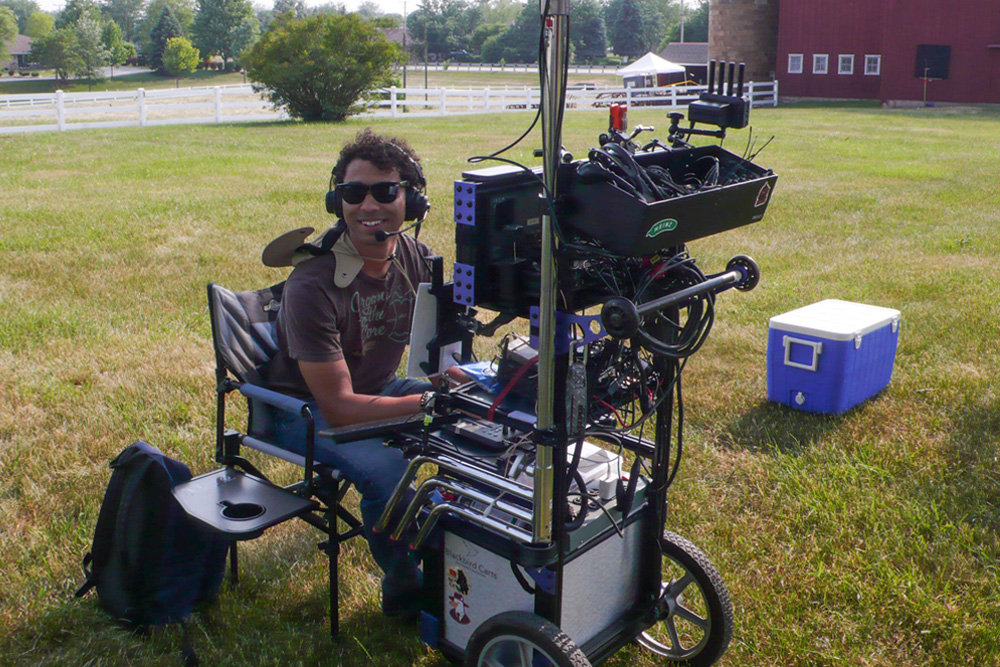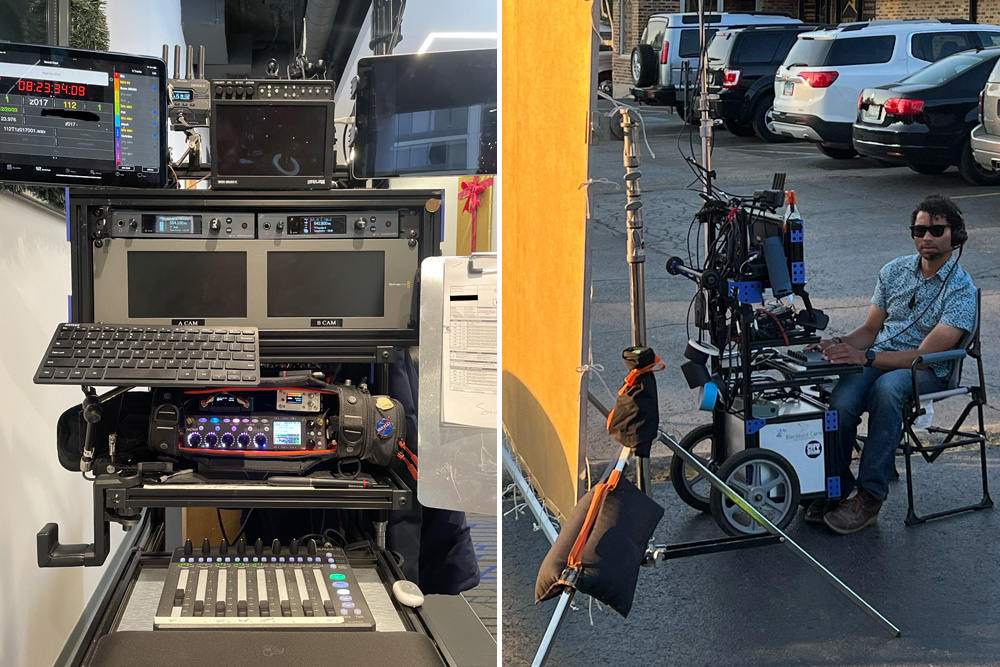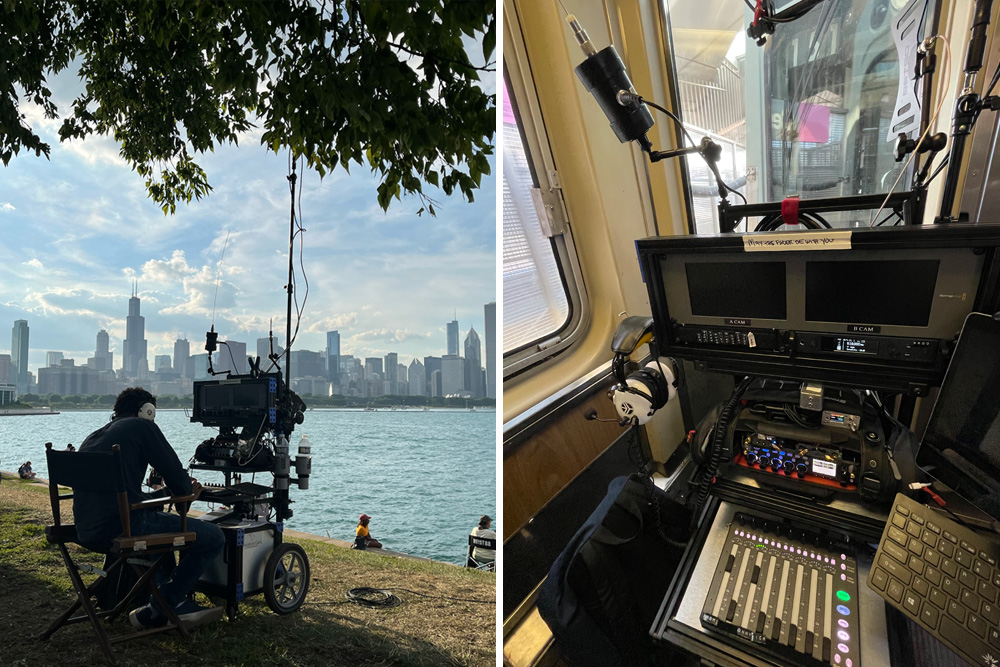
“It was a desire to be more technical,” Jacob Brown says during a call as to why he prefers being a production sound mixer over other crafts in location sound recording. “I enjoy having a little more control over the quality of what we were handing over at the end of the day.” The Chicago native shares that a background in music is what led him down the path of becoming a mixer. “I was composing and meeting different filmmakers early on and then I wandered down the road of being more interested in the application of engineering and the slightly artistic side that recording good sound on set requires,” he says.
The curiosity has paved a productive career for Brown who’s been mixing commercials, docs, movies, and TV series for over a decade in the Chicagoland area, a film community he mentions is “pretty small and tight-knit.” “Even if you work on a wide variety of projects in Chicago, the same six or seven people will pop up on the call sheet a few times every year.”
Collaborations from those projects has led to future work for the mixer, including director Ben Kitnick’s raunchy comedy Let’s Make a Cult (2024), starring the hilarious Stavros Halkias as Chip Harper, a man obsessed with starting his own cult. Brown landed the gig through connections with producer RoseMary Prodonovich and cinematographer Jason Chiu, the latter of which he worked with on Alex Heller’s stirring family drama The Year Between with Steve Buscemi and J. Smith-Cameron as parents navigating their college-aged daughter’s newly diagnosed mental illness.

For the majority of projects, Brown looks to the Zaxcom Nova and the Aria mixing panel as his main setup. He uses the Nova’s built-in slots for two MRX414 receivers, giving him up to 8 channels of wireless audio. For transmitters, a grouping of TRXLA3 and ZMT3 transmitters are combined with DPA or Sanken lavs, and depending on scene needs, a wireless boom with a TRX743 or ZMT3-Phantom transmitter is paired with a variety of overhead mics, including the Sennheiser MKH 416, MK-50, or MKH 8050 as well as the Schoeps CMIT-5U. He notes tech scouts are an important part of the equation to recording quality location sound. “I definitely become close friends with the electric department so we can work out the optimal location for any generators. This way, if I know they are going to be close, I ask if we can do baffles. Then with HVAC units, I connect with the location department and then with set dressers to know where we can lay carpets on the day. It’s a collaborative effort early on where we are all working together to figure out the next solution in the chain.”
In prep, Brown will break down the script and meet with producers and/or the director(s) to troubleshoot questions. Among his common asks include things like the preferred number of wireless, the extent of communications and IFB on set, if he’ll need to integrate with video assist, and the general approach to shooting. “Most of the conversation I’m having with producers is about context and how do I get production what they need in order to feel comfortable with what we’re shooting,” he explains.
Brown’s approach to mixing is similar to his peers, with track one being a mono mix followed by the boom and ISO tracks. He prefers not to EQ any microphones, but depending on the environment, will add roll off to the low end. He’s also one to let the boom operator run the set, and that was the situation for boom operator Chris Nawrocki on Let’s Make a Cult. “I try to be on set for the read through and the blocking but I’ll let Chris have the set to walk through and isolate sound issues unless he needs an extra hand.” Brown also entrusts his utility to wire talent and additional booming. “Chicago has great utilities and it’s important for them to have good wiring ability because as a sound mixer we can be off in a different room or in a closet all day. The boom operator and utility are the face of the sound department, so they have to have that ability to connect with people and communicate what they need. It goes beyond the tech and technical skills.” However, Brown does step in when required. “If we maybe need another take for sound, I’ll check in with the director of photography before going to the director because they might be doing six other things.”

When asked about overcoming sound hurdles on Let’s Make a Cult, Brown had two that came to mind. “The first is when Stavros is at breakfast with his family. He and Robert Kelly, who is playing his father, were giving such variable and large dynamic range that I needed to ride the gain through the scene and anticipate how loud they were going to take, not just the scene, but each line,” he continues. “The second was the golf course sequence because we were tracking the group as they rode all around the course on a gator and bikes. We needed to be mobile, so I put the Nova in a bag with a pair of BlueFin 2 antennas and rode around on the back of a golf cart, making sure I could be right alongside them for good reception without missing a beat. Additionally, the picture gator was quite loud, so thankfully Ben, Stavros, and the cast were receptive to trying to deliver their lines off throttle.”
On the documentary The Big Payback, a visceral look at politician Robin Rue Simmons’ fight against redlining (the practice of denying services to residents based on race or ethnicity) and the groundbreaking reparations program in Evanston, Illinois, Brown relied on Zaxcom’s internal recording feature, which allows users to simultaneous transmit and record audio to an internal memory card. “Having that as a backup very much provides peace of mind,” he asserts. “It’s more of an insurance policy, but I will have to pull the cards from the transmitters from time to time.”
Even with the run and gun style shooting of the doc, Brown will always record a boom mic for environmental sounds or to capture any conversation from someone unexpectedly walking into the frame. Besides the boom, he ran four transmitters out of a sound bag with the Zaxcom Nova as his main recorder. In one sequence he found himself in a crowded public demonstration. “We did a portion following Robin in D.C. at a rally and we were covering her with a single camera all around the Lincoln Memorial in the middle of this rally,” he explains. “We had a few people wired with Zaxcom transmitters and I grabbed a ZMT3-Phantom and popped it on the press box. I was able to have everything on timecode and then was able to make a copy of everything that was being sent out from the podium mics”

Another project Brown utilized the Zaxcom internal recording on was the Showtime series Heist 88 starring Courtney B. Vance as a criminal mastermind who recruits bank employees to steal $80 million in one of the biggest heists in U.S. history. “In one scene we were shooting on a train – a live train that’s going through downtown Chicago at 20-30 miles per hour. I remember thinking if I didn’t have the security blanket of knowing the mics were also recording internally it would have been a big headache of the day. There was just no way to run an RF scan for how fast the train was moving.”
Brown is also a prominent ZaxNet user, which allows the remote control of key functions on Zaxcom Digital Recording Wireless. ”I’ve always been pretty happy with my gain staging and levels and everything. But the big thing for me integrating Zaxcom into my kit was because of ZaxNet. Now I could have control over the levels on the transmitter and change things mid-scene if necessary. Knowing that I have an extra degree of control is very helpful,” he says. “Sometimes I’ll work with a boom operator or a utility and they’re like, oh, right, we don’t need to go approach talent for these things. And that’s also nice because sometimes if you have to, it might take talent out of their acting headspace.”
The mixer also prefers recording sound to reflect the production environment. “The goal with the mix is to deliver something as close to what you’d want to be listening to in the theater as possible. That comes from this attitude of instead of fighting with the locations, let’s embrace them. Let’s take care of what we can but then once we’ve got everything to an acceptable level and we’ve done everything, we can embrace it. I learned that from an earlier project in my career called Tom of Your Life,” he says. “There was one scene where we were in this cavernous church in Chicago and it had this beautiful reverberation. So I threw some mics up in the balcony to record all of it and we really leaned into it.”
When asked what features he’d like to see in future Zaxcom products, he suggested more integration. “If they were able to integrate something like a TRXCL5 transmitter into the Nova or Deva to send a feed to a URX50 or URX100 for crew, that would mean one less transmitter to coordinate. Bankable faders for the Aria would be another really big thing I’d be looking for.”
You can catch up more with Jacob Brown here.